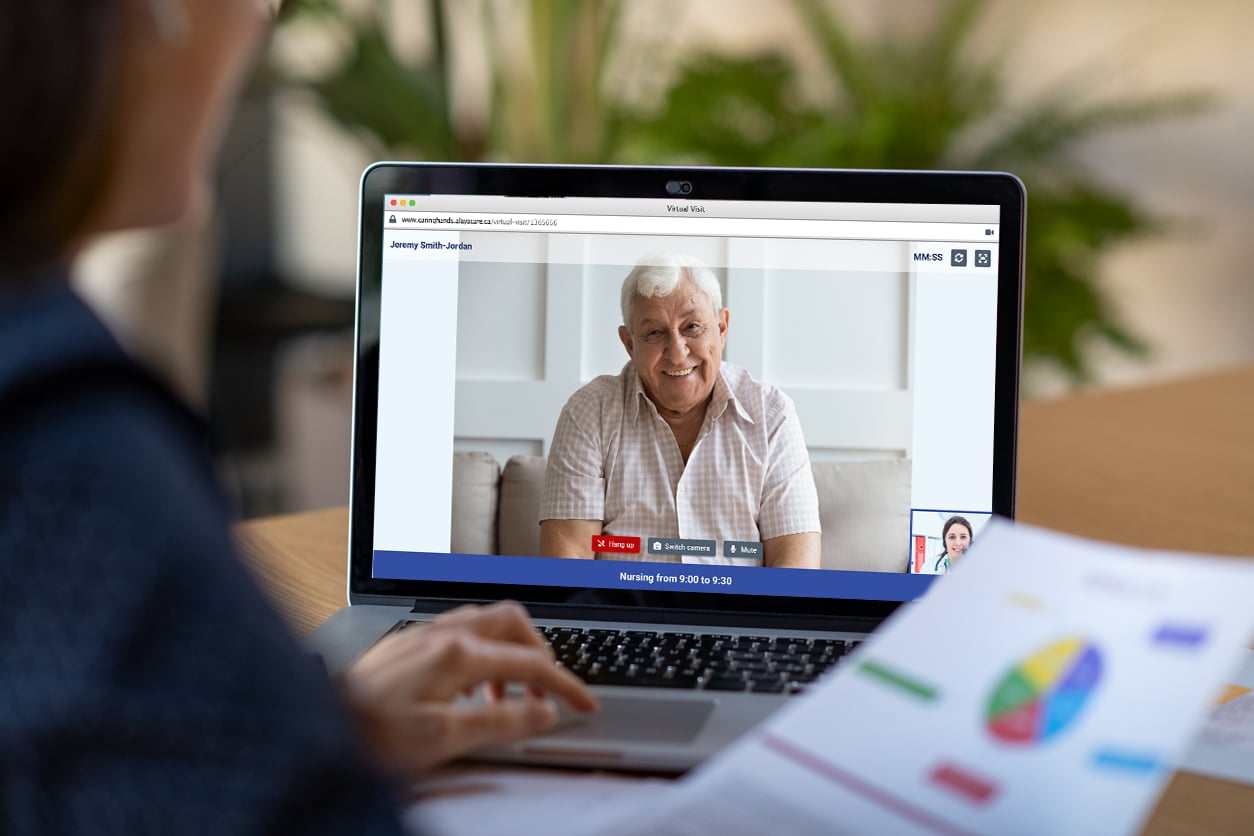Blog
The Rise of Hospital at Home

Ravaged hospitals. Overrun intensive care units. Front-line workers facing burnout from what must seem like an endless stream of impossible days – yet they continue to persevere as the COVID-19 crisis continues.
With all the attention on the coronavirus, it’s easy to overlook the many chronic diseases that were plaguing the system before the pandemic began. These diseases of course are still present; for families and their health-care teams, it’s just become more challenging to manage them.
We’re waging battles on multiple fronts – and, like battles before this, our hospitals, governments and home care industry have tried to step up to provide solutions. In overlapping efforts to compensate for the incredible events of the past 10 months, they have ramped up PPE production, pivoted to new models of care, and accelerated technology, all in an effort to increase efficiency, safety – and generate better outcomes.
Accelerated production of PPE and flex care solutions
While the overall response to COVID has been uneven, to put it one way, there has been a strong push at many levels to bolster PPE production (an acronym everyone now understands), increase hospital ward capacity, and think generally outside the box when it comes to patient care.
The Centers for Medicare & Medicaid Services (CMS), for instance, announced a new strategy to add flexibility to the U.S. health-care system outside traditional hospital settings. Alongside expanded telehealth options and updated rules for ambulatory surgical centers to perform more inpatient procedures was a new Acute Hospital Care at Home initiative.
This program, expanding on the Hospitals Without Walls effort from last spring, allows for qualified hospitals and health-care institutions to provide safe hospital care for eligible patients inside the home. Patients cared for at home in this model are those who were recently in an emergency department or in an inpatient hospital bed. It blends remote and in-person visits by registered nurses and integrated health paramedics, tied back to an individual’s care plan.
These efforts have proven vital to dramatically boost the nation’s capacity to deal with a broader spectrum of chronic health issues such as cancer, diabetes, metabolic disease, heart disease and chronic obstructive pulmonary disease – and manage the deep impact these issues have on families and on the system at large.
The new venue for the future of care: at home
Today, physicians, nurses, therapists and aides are visiting these patients far more frequently in their homes than in a clinical care setting. It’s been a necessary and rapid change forced by the pandemic to safeguard hospital capacity. Yet we expect this shift to remain long after COVID-19 fades into the awful memory (and learning opportunity) it will become.
That’s because the future of health care is in the home; indeed, research shows that home care can be as or more effective than hospital-based care. This was the case well before COVID-19, as hospital-at-home programs have proven successful at improving patient outcomes while reducing health care costs (as evidenced in this 2012 Johns Hopkins study). Yet in parallel with this shift to the home, it’s now more important than ever to empower family caregivers with the training, knowledge and equipment to keep patients safe.
Fortunately, that’s exactly what programs like Acute Hospital Care at Home are designed to do, and our industry is fortunate to have leaders like Dr. Bruce Leff, who deserves his reputation as a founding father of this virtual hospital concept and as a promoter of more comprehensive, patient-centred care.
Importantly, the new hospital-at-home care program sets it up to be realistically successful, as some of the conditions in this FAQ document reveal. It advises that physicians or nurses should lead care, and orient others in a person’s circle of care to the plan in place. And it correctly points out that many different types of care are needed to meet a person’s needs from nursing, wound care and home infusion to physio and occupational therapy, to social work and personal care. It is pragmatic in guiding that delegated authority and care coaching are needed to relieve burden from family caregivers and that virtual care and remote monitoring are necessary in managing care plans in order to avoid return trips to the hospital.
Technology’s role in the hospital-at-home movement
We know that for any innovative systems of care to be successful, they must deliver a care experience that is at least on par with what patients would find at the hospital. Technology is the conduit through which these evolutions can work effectively.
The following software areas are prime for ensuring continuity of care while keeping clients and care professionals safe:
Mobile technology: Care workers must operate with maximum flexibility, able to access data and clinical documentation even in offline mode. Mobile apps are best designed as relevant to each individual worker’s role – reflecting, for instance, the appropriate tasks for nursing, various types of therapy, home infusion and personal care, as well as including even social/behavioural interventions.
Real–time connectivity: In the hospital-at-home model, there is of course no nurse station to visit. Yet, here, technology can significantly close the gap by bringing clients into a virtual ward where two–way dialogue is possible between care professionals and the clients they serve.
Virtual visits: In 2020, we witnessed the rise of virtual care in swift fashion out of immediate necessity. Physicians in many disciplines now, beginning with primary care and extending to specialist care, have made this a new normal. Virtual care has also made great strides within the home and community care space as well.
Home Infusion: for various clients incapable or unwilling to visit hospital, home infusion is a viable option – and it’s now possible to be done virtually. (Clinics can learn best practices from providers such as Option Care Health.)
Interoperability/Integrations: Because Acute Hospital Care at Home is a waiver program tied to a hospital or health system, the expectation is that more than one software system will require integrations. Modern technologies rely upon APIs to enable a best of breed experience. A single hospital EMR is highly unlikely to support enough use cases to work stand-alone as much as the hospital-at-home solution.
Care delivery and reimbursement options for progressive agencies
Again, the distinction between the hospital-at-home scenario and home care industry is important. Key differences include:
- No OASIS requirement
- The care is often for chronic illnesses or care that requires home infusions and therefore isn’t episodic
- The care is not part of a Medicaid personal care waiver program with 15–minute increment billing units.
This care delivery is meant to mirror the experience in a hospital setting, therefore a home care agency looking to enter this space is more likely to follow their private duty line of business reimbursement method. In some cases, however, the relationship between agencies and hospitals is more tightly integrated and aligned in the form of risk/performance–oriented contracts. These agreements share both risk and reward of care plan goals – beyond authorization dollar limits or reaping bonuses for completing care on time and on budget.
In part two of this blog post, we’ll hear from Joel Theisen at Lifesprk – a progressive agency delivering multiple modes of care that has extensive relationships with several payers, hospitals, and insurance companies.
Be sure to watch our roundtable discussion with Joel, alongside hospital-at-home pioneer Dr Bruce Leff, journalist Robert Holly, and AlayaCare’s CEO Adrian Schauer. Check it out below:
Visit our hospital-at-home page for more information and to reach out to us to see how we can set you up for success.







